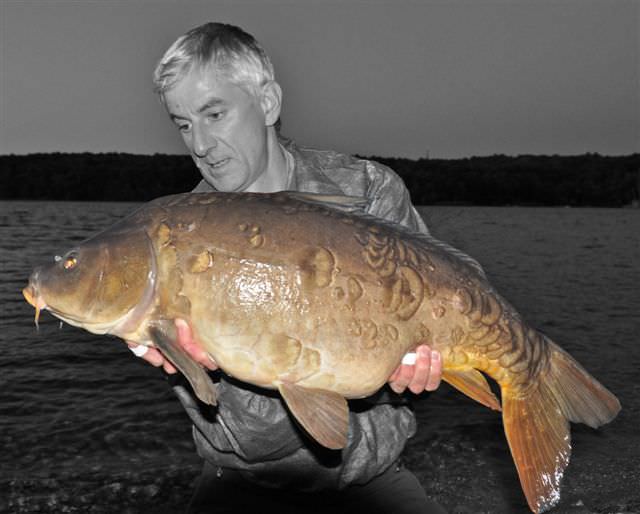There are rarely any short cuts to consistently catching big carp… even here in the USA.
However there are some basic rules that when followed will certainly increase your chances of success….
Rule #1 Fish where the fish are…

An obvious statement perhaps but it’s one that is too often overlooked!
If you are focused on catching a big fish then choose a water that can produce fish of the appropriate caliber. This might seem obvious but the more time spent on research instead of fishing with your fingers crossed will not only increase your chances significantly but make your fishing time more productive. Local tackle stores, carp & non-carp fishing forums, state citations and even bow hunting reports can be invaluable in tracking down a big fish venue.
Here in the USA we have thousands of untapped carp waters that have yet to reveal their true potential. There is every reason that with a little effort you can look beyond well known fishing spots and find one of your own. Knowledge is power and every year we are seeing more & more anglers catching bigger & bigger fish from new locations!
And please don’t be offended when someone on a carp forum refuses to give away their secret hot spots… they’ve probably invested a lot of time & effort to find them and are unlikely to invite you along without at least getting to know you first!
So let’s assume that you’ve found a water that is reputed to hold big carp… what comes next?
Rule #2 Understand the water…
There are some fundamental fishing skills that have little to do with casting a line out. It’s much more about where & when to cast your bait that results in a fish in the net!
The approach to a 5 acre pond should not be so fundamentally different to a 10,000 acre reservoir. Once you pay attention to the following factors you’ll have a better chance to find & observe the fish and more importantly start catching them.
Key factors in locating carp are wind direction, depth, contours, structure & temperature.

Fishing into the wind is perhaps the most important, yet under estimated, factor on choosing a swim. If the prevailing wind is from the south west then food will be blown on to the north east shoreline. Fish will follow the wind and the food source. When ever you can always fish into the wind. If it changes direction then it is often a good idea to make a move to a new swim.
Carp like to follow contours as it provides protection and concentrates food. These include bankside or island margins (providing there is no disturbance from human activity), drop offs, weed beds etc. Understanding these underwater features will help in deciding where to position your baits. A marker float will help you map out these features while on larger waters using topographical maps or a depth sounder can be invaluable.
Temperature affects carp feeding activity… too hot and the water can be depleted of oxygen while too cold and the fishes metabolism slows down. Deeper water can provide stable temperature zones in the depths of winter or the heat of summer. Shallow water areas or humps will warm quickly in the sun which makes them a good place to focus in early or later season.
Weed and reed beds offer shelter as well as food and fishing in or near them is invariably a good starting point.
Once you understand how to identify these features and areas you can then look for signs of carp. Carp crashing may or may not be a sign of feeding but carp porpoising or rolling on the surface is certainly a promising sign. In shallower water you may see clouded areas and bubbles are coming up to the surface as the carp stir up the bottom.
Invest some non-fishing time walking around the lake (especially at dawn or dusk) with polarized glasses and binoculars as the results can make your angling all the more productive.
Rule #3 Fish when they are feeding…

In most North American waters carp will feed continually… that is perhaps a contentious statement but it’s one that I’m happy to defend!
This feeding activity may drop off significantly in the depths of winter but as we are learning carp really do not hibernate as once assumed.
When folk claim that the carp are not feeding I actually believe that they are more likely feeding somewhere else or are pre-occupied with another food source. The only exception might be during the spawn… but even then they will often take something. Unlike densely populated small European waters of just a few acres the carp in North America simply cannot rely on a steady supply of boilies to keep their stomachs filled. The bulk of their diet is natural food such as crayfish, bloodworms, daphnia, vegetation etc so they tend to follow these food sources.
The key to catching carp consistently is to ensure they are feeding in your chosen area & when you are fishing… This could mean moving from one swim to another if nothing is happening or embarking on a regular baiting program to ensure they are in a particular swim when you plan to fish.
There is nothing to beat a consistent baiting or chumming program to maximize your chances… carp will quickly respond to finding a new and easy source of food. If you chum in a line at an angle to where you are fishing then you have more chances of intercepting cruising fish and can position your baits at different distances. If you see fish over the chum ‘line’ then reduce the area to where you see most activity and position your baits accordingly.
However be sure to bait up at the same time each day so that the carp include this new food source in their regular patrol and feeding patterns. And don’t expect that if you feed the fish every evening you can turn up and catch fish in the morning… fish at the same time as you feed.
Rule #4 Keep it on target.

I cannot count the number of times that I’ve seen folk chum an area and then cast their bait short or wide… and then leave it there! You might pick up the odd stray fish but if the fish are actively feeding over your chum area why position your bait 20 yds away?
There is, however, an argument for placing a bait on the edge of the main chum area. The theory is that smaller, more aggressive fish will be in the main area while larger more cautious fish hang around the outer edges. I’m not convinced and over the years have found that minimizing the amount of bait / chum (especially particles) when fishing not only keeps the fishing area smaller but encourages more aggressive feeding behavior from the bigger fish.
It is also critical to chum accurately… if you spread your chum over a 20 x 20 yard area instead of a 5 x 5yd that is 400 sq yards vs 25 sq yds. That’s a huge area for the fish has to find your bait! In the chum ‘line’ above the secret is in keeping the chum line narrow and your casting accurate… that way the carp will absolutely have to intercept your bait as they move up & down the line.
Another issue is putting in too much chum with the result that your hook bait becomes the proverbial needle in a haystack. The old fishing saying of ‘you can put it in but you can’t take it out’ reflects on the best approach of ‘feed a little but often’.
Accurate casting comes with practice… unlike a side cast an overhead cast will keep the rod tip tracking in line with the target. There are also some useful tricks. An object on the far bank can be used as an aiming point and a marker (a piece of pole elastic or colored braid) on your line will ensure the correct distance is reached). If you consistently cast to the right or left of your intended target you probably suffer with a dominant eye like me… Close the weaker eye and you cast will straighten up like magic!
Rule #5 Keep it simple…

While there is no substitute for quality fishing gear when chasing hard fighting fish like carp it’s sometimes easy to get ‘blinded’ by all the European magazine articles, rigs, tackle and baits. Well tied, simple hook rigs (such as KD or Bottom bait rigs will catch you 90% of the carp here in the USA. Remember the old saying that it’s a bad workman who blames his tools…
There are a thousand different baits, flavors, chum recipes & opinions that all promise success. My advice is to start simple… some fruit flavored boilies fished over a bed of particles (field corn) or animal feed pellets is an easy and economical start. Sweetcorn or bread fished directly on the hook are probably among the most reliable and instant baits of all time. Once you gain experience then its time to experiment a little at a time and by keeping notes you’ll soon learn what works best on your chosen water.
On the topic of keeping notes a fishing log not only provides a record of your captures but can become an invaluable reference for understanding how successful one bait is over another or which rig has better hook-ups etc. I also like to record weather conditions, water temperature – not just at the surface but also on the bottom which can be done by measuring the lead using an infra red thermometer. Reading back over my successes and failures over the years is not only entertaining but also invaluable to making my fishing more productive and rewarding.
While distance casting is an important part of the carp fisherman’s armory it is often at the expense of missing fish right under the rod tip. Carp love to cruise the margins – especially at night and often in just 2 or 3 feet of water. Don’t miss exploiting these opportunities!
If you follow these basic rules you’ll be well on the way to catching bigger carp on a regular basis and you might even end up with that PB…
Good luck!

